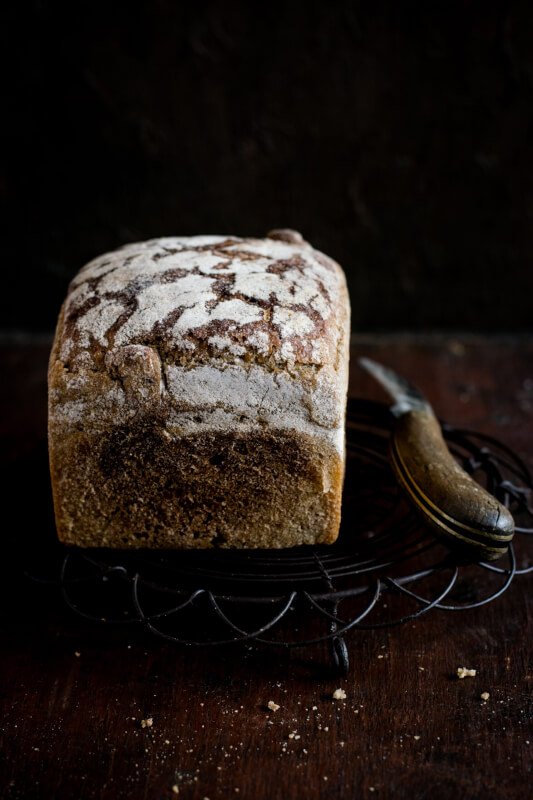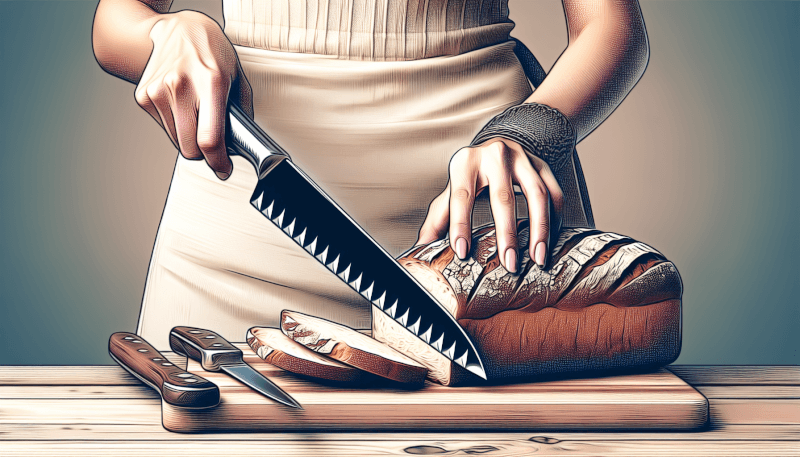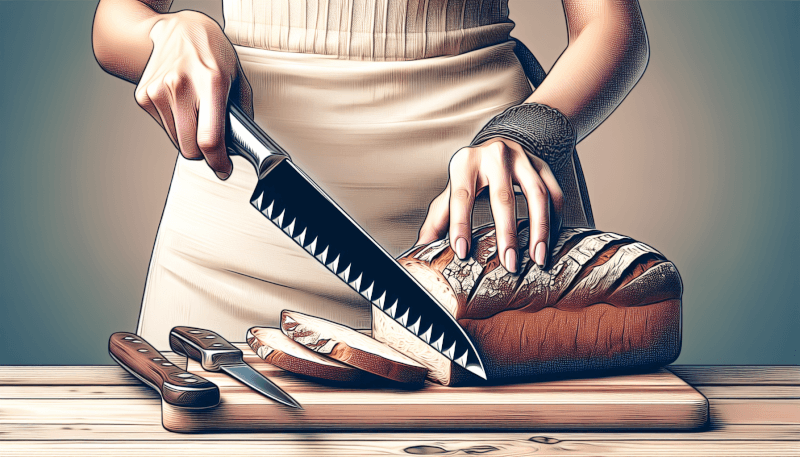Are you tired of struggling to slice bread with a dull knife? Look no further, because in this article, we will provide you with valuable tips on selecting the perfect knife for slicing bread. From the blade type to the handle material, we will guide you through the factors to consider in order to find the best knife that will effortlessly glide through your loaves of bread and leave you with perfectly even slices every time. Say goodbye to uneven, torn bread slices and say hello to a satisfying and enjoyable bread slicing experience. Get ready to become a bread slicing pro with the right knife in hand!

Blade Type
Serrated Blade
A serrated blade is a popular choice for slicing bread. The sharp, jagged teeth on the blade help to grip the bread’s crust and prevent it from being crushed or squished during slicing. The saw-like action of the serrated blade effortlessly cuts through the crust, while the pointed tips penetrate the bread’s soft interior. This type of blade is perfect for slicing through crusty artisan breads or delicate pastries without compressing them.
Scalloped Blade
A scalloped blade, also known as a wavy blade, is another option for slicing bread. The curved, wave-like edges of the blade allow for smooth slicing without tearing or ripping the bread. The scalloped edges reduce friction and prevent sticking, resulting in cleaner cuts. This type of blade is especially useful for slicing soft breads like brioche or challah, as well as cakes and other baked goods.
Straight Blade
A straight blade is a versatile option that can be used for slicing bread as well as other kitchen tasks. While it may not have the specialized features of a serrated or scalloped blade, a sharp straight blade can still yield excellent results when slicing bread. This type of blade is often found in multi-purpose knives and can be a good choice if you’re looking for a knife that can handle a variety of slicing tasks in addition to bread.
Blade Length
7-9 inches
A bread knife with a blade length of 7-9 inches is a common and practical choice for most home cooks. This length is suitable for slicing through most standard loaves of bread, whether they’re small or large. The shorter blade offers more control and maneuverability, making it easier to navigate around the curves and corners of a loaf.
9-10 inches
If you frequently handle larger loaves or prefer a longer blade for slicing, a knife with a 9-10 inch blade length may be preferable to you. The extra length provides more leverage and allows for smoother, longer strokes when slicing through larger loaves. This can be particularly useful when slicing baguettes or other elongated breads.
10+ inches
A bread knife with a blade length of 10 inches or more is ideal for professional bakers or individuals who frequently work with oversized loaves or artisan breads. The longer blade offers greater reach and can effortlessly slice through thick, crusty breads. However, it’s worth considering that a longer blade may require more control and may be less suitable for precise or delicate slicing tasks.

Blade Material
Stainless Steel
Stainless steel is a popular choice for bread knife blades due to its durability, resistance to corrosion, and ease of maintenance. A stainless steel blade retains its sharpness for a long time and can withstand regular use without losing its edge. Additionally, stainless steel blades are less likely to stain or react with acidic ingredients present in some bread recipes.
High Carbon Steel
High carbon steel, often referred to as simply carbon steel, is known for its exceptional sharpness and edge retention. This type of blade material is favored by professional chefs and bread enthusiasts who value precision and longevity. However, it’s important to note that high carbon steel blades require regular maintenance to prevent corrosion and staining.
Ceramic
Ceramic blades have gained popularity in recent years for their exceptional hardness and ability to retain sharpness. A ceramic blade can effortlessly slice through bread without crushing or tearing, resulting in clean cuts. They also do not react with acidic ingredients and are resistant to rust. However, ceramic blades are more delicate and prone to chipping or breaking if mishandled or dropped.
Handle Material
Wood
A wooden handle not only adds a touch of elegance to a bread knife but also provides a comfortable grip. Wood is relatively lightweight, making it easy to maneuver during slicing. It also offers a natural warmth and texture that many cooks find appealing. However, wood handles require more care and maintenance to prevent drying out or cracking.
Plastic
Plastic handles are a popular choice for bread knives due to their affordability and durability. They are lightweight, easy to clean, and resistant to moisture. Many plastic handles are ergonomically designed to provide a comfortable grip, making it easier to control the knife while slicing. Additionally, plastic handles are less likely to absorb odors or stains.
Stainless Steel
Stainless steel handles are a sleek and modern option for bread knives. They are durable, corrosion-resistant, and easy to clean. Stainless steel handles often have a brushed or polished finish, adding an aesthetic appeal to the knife. However, it’s worth noting that stainless steel handles can become slippery when wet, so it’s important to ensure a secure grip during use.

Weight and Balance
Lightweight and Balanced
A lightweight and balanced bread knife is an excellent choice for individuals who prefer a knife that feels nimble and responsive in their hand. This type of knife is easy to control and maneuver, allowing for precise and effortless slicing. The balance refers to how the weight of the blade is distributed, with a well-balanced knife ensuring optimal control and reducing the strain on your hand and arm during use.
Heavier and Balanced
A heavier and balanced bread knife can offer more power and stability when slicing through dense or crusty breads. The weight of the knife provides a natural momentum, reducing the effort required to cut through the loaf. This type of knife is favored by professional bakers or individuals who frequently work with challenging bread textures.
Personal Preference
When it comes to weight and balance, personal preference plays a significant role. Some individuals may prefer a lightweight knife for its maneuverability and ease of use, while others may find that a heavier knife provides more slicing power. It’s important to consider your own comfort and preferences when choosing a bread knife, as the right weight and balance can greatly enhance your overall cutting experience.
Ease of Maintenance
Dishwasher Safe
If convenience is a priority for you, a bread knife that is dishwasher safe can make your cleaning routine a breeze. Dishwasher safe knives can be placed in the dishwasher along with your other utensils, saving you time and effort in hand washing. However, it’s important to note that frequent exposure to the high heat and harsh detergents in a dishwasher can potentially dull the blade or damage the handle material over time.
Hand Wash Only
Many bread knives require hand washing to maintain their sharpness and longevity. Hand washing allows you to carefully clean and dry the blade, reducing the risk of corrosion or staining. It’s recommended to wash the knife with warm, soapy water immediately after use and dry it thoroughly before storing. Taking proper care of your bread knife through hand washing can help to preserve its performance and appearance.
Ease of Sharpening
Regardless of whether a bread knife is dishwasher safe or requires hand washing, its ease of sharpening is an important consideration. Over time, even the best blades will require sharpening to maintain their cutting performance. Some knives may be more easily sharpened at home using a sharpening stone or honing rod, while others may require professional sharpening services. Consider your own sharpening skills and preferences when selecting a bread knife.

Brand Reputation
Well-known Brands
There are several well-known brands in the market that have established a solid reputation for producing high-quality bread knives. These brands often have years of experience and a commitment to crafting reliable and durable kitchen tools. Opting for a bread knife from a well-known brand can provide peace of mind and confidence in the product’s performance.
Specialized Bread Knife Brands
In addition to popular kitchenware brands, there are specialized brands that focus specifically on bread knives. These brands may have developed unique blade designs or handle materials specifically tailored for optimal bread slicing. Consider exploring these specialized brands to find a knife that meets your specific bread slicing needs.
Customer Reviews
Another useful way to gauge the reputation and performance of a bread knife is by considering customer reviews. Reading reviews from other individuals who have purchased and used a specific knife can provide valuable insights into its performance, durability, and overall satisfaction. Keep in mind that individual experiences may vary, but customer reviews can offer a helpful perspective when making your decision.
Price Range
Budget Options
If you’re on a tight budget, there are still many affordable bread knife options available. These budget-friendly knives can offer reliable performance for everyday bread slicing needs without breaking the bank. While they may not have all the bells and whistles of higher-end knives, they can still get the job done effectively.
Mid-range Options
Mid-range bread knives typically offer a good balance between price and performance. These knives often come from reputable brands and feature quality materials and craftsmanship. Investing in a mid-range bread knife can provide a durable and reliable tool that will serve you well for years to come.
High-end Options
For those who are willing to invest in a top-of-the-line bread knife, high-end options offer the utmost in performance, craftsmanship, and materials. These knives are designed to provide exceptional slicing precision, durability, and aesthetics. While they may come with a higher price tag, high-end bread knives can be a worthwhile investment for serious bread enthusiasts or professional bakers.

Personal Preference
Grip and Ergonomics
The grip and ergonomics of a bread knife are essential factors to consider, as they can greatly influence your comfort and control while slicing. Look for a knife with a handle that feels comfortable in your hand and allows for a secure grip. Ergonomic designs with contours or textured grips can enhance stability and reduce fatigue during long slicing sessions. It’s important to hold the knife and assess its grip and ergonomics before making a decision.
Aesthetics
While aesthetics may not directly affect the performance of a bread knife, they can contribute to your overall enjoyment of using the knife. The appearance of the blade, handle, and any additional decorative elements or patterns can add a touch of style and personality to your kitchen. Whether you prefer a classic and timeless design or something more modern and eye-catching, choose a bread knife that appeals to your personal taste.
Overall Feel
Ultimately, the most crucial consideration when selecting a bread knife is how it feels in your hand. The weight, balance, grip, and overall feel should align with your preferences and allow for comfortable and efficient slicing. Assessing the knife in person, if possible, can give you a better sense of its overall feel and suitability for your needs. Remember that the right bread knife should make slicing bread a pleasure rather than a chore.
Additional Features
Bread Crumb Catcher
Some bread knives come with a built-in bread crumb catcher or a scalloped edge design that helps to prevent crumbs from scattering across your cutting surface. This additional feature can be particularly useful if you prefer to maintain a clean and tidy work area while slicing bread. Consider whether a bread crumb catcher is a desirable feature for you when selecting a knife.
Slicing Guide
A few bread knives include a slicing guide or markings on the blade. These guides can help you achieve uniform slices of bread by providing a visual reference for the desired thickness. This feature can be especially helpful if you’re looking to achieve consistent slices for sandwiches or presentation purposes. If precision slicing is important to you, consider a knife with a built-in slicing guide.
Storage Case
For those who want to protect their bread knife when not in use or during travel, a storage case can be a valuable addition. A storage case provides a safe and secure place to store your knife, protecting the blade from damage and preventing accidents. Additionally, a storage case can help to keep the knife easily accessible and organized in your kitchen.
In conclusion, selecting the best bread knife for your needs involves considering factors such as blade type, blade length, blade material, handle material, weight and balance, ease of maintenance, brand reputation, price range, personal preferences, and any additional features you may desire. By taking the time to evaluate these aspects, you can find a bread knife that meets your requirements and enhances your bread slicing experience. Happy slicing!


